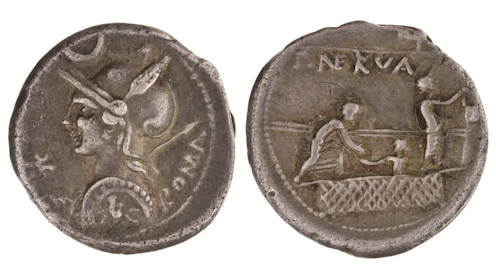Ancient Rome successfully fought against voter intimidation − a political story told on a coin that resonates today
- Written by David B. Hollander, Professor of History, Iowa State University

This silver denarius, minted over 2,000 years ago[1], is hardly the most attractive Roman coin. And yet, the coin is vital evidence for the early stages of a political struggle that culminated in Caesar’s assassination and the fall of the Roman Republic.
I first encountered this coin while studying Roman history[2] in graduate school. Its unusual design gave me pause – this one depicted figures walking across a narrow bridge and dropping something into a box. I moved on after learning it depicted voting, reasoning that Roman mint officials[3] occasionally made idiosyncratic choices.
But as voting access evolves in the U.S., the political importance of this centuries-old coin seems more compelling. It turns out that efforts to regulate voting access go way back.
Roman voting
Voting was a core feature of the Roman Republic and a regular activity for politically active citizens[4]. Men, and only men[5], could vote in multiple elections and legislative assemblies each year. So why would P. Licinius Nerva, the official responsible for this coin, choose to depict such a banal activity?
The answer lies in voting procedures that sometimes heavily favored elites.
In the comitia centuriata[8], the assembly that elected Rome’s chief magistrates, each citizen was a member of a voting unit based on wealth. Unit members voted to decide which candidates they collectively supported, like U.S. presidential elections where it’s not the popular vote but the number of Electoral College votes[9] that determines the winner.
The wealthiest Romans controlled more than half of the voting units in this assembly. The poorest citizens had just one voting unit; since they voted last, and only during uncertain outcomes, they might not vote at all.
Furthermore, citizens voted orally and openly. Elites could directly observe and potentially intimidate poorer voters.
Regulating Roman electioneering
That all began to change in 139 BCE when the Roman politician Aulus Gabinius passed a law[10] mandating written ballots for elections. Two further laws, both passed in the 130s[11], extended the use of written ballots to legislative voting and most trial juries.
These written ballots made it more difficult for elites to influence voting but not impossible. Each unit formed its own line leading to a bridge where voters received ballots to mark and place in a basket[12]. Elites could station themselves or their allies on the bridge to encourage people to vote the “right” way.
The reverse of Nerva’s coin depicts the reception and deposit of the ballot, the first and last moments of a voter’s time on the bridge. The absence of nonvoter figures on the coin, apart from a poll worker, is key to understanding its message.
In 119 BCE, a young politician named Gaius Marius passed a law[14] that narrowed voting bridge widths[15], allowing voters to mark their ballots without elites looking over their shoulders. Nerva’s coin, minted six or seven years later, almost certainly refers back to this law[16]. By showing only voters on the bridge, Nerva was celebrating an important voting rights victory and announcing his allegiance to Marius.
The aristocrats never managed to repeal the voting laws and were still grumbling about them[17] even as the Republic collapsed.
The long Roman struggle over voting procedures provides a useful and perhaps even comforting reminder. Changing state voting laws[18] and election lawsuits[19] are nothing new. The fight over voter access to the ballot is an inevitable side effect of democracy.
References
- ^ over 2,000 years ago (numismatics.org)
- ^ studying Roman history (history.iastate.edu)
- ^ Roman mint officials (doi.org)
- ^ regular activity for politically active citizens (archive.org)
- ^ Men, and only men (doi.org)
- ^ BeBo86/Wikimedia Commons (commons.wikimedia.org)
- ^ CC BY-SA (creativecommons.org)
- ^ comitia centuriata (doi.org)
- ^ number of Electoral College votes (theconversation.com)
- ^ Aulus Gabinius passed a law (data.perseus.org)
- ^ both passed in the 130s (archive.org)
- ^ place in a basket (hdl.handle.net)
- ^ American Numismatic Society (numismatics.org)
- ^ passed a law (data.perseus.org)
- ^ narrowed voting bridge widths (www.loebclassics.com)
- ^ refers back to this law (doi.org)
- ^ still grumbling about them (data.perseus.org)
- ^ Changing state voting laws (tracker.votingrightslab.org)
- ^ election lawsuits (www.democracydocket.com)
Authors: David B. Hollander, Professor of History, Iowa State University

